Uh oh… you’ve got algae in your saltwater pool.
Don’t panic. You’re not the first pool owner to wake up with green, yellow, or black algae in your pool, and you certainly won’t be the last.
In this article, we’re going to show you exactly how to remove algae from a saltwater pool, step-by-step.
Why Do You Have Algae in Your Saltwater Pool?
You might not realize this, but algae are constantly getting into your saltwater pool through various means.
Depending on the type of algae, it can latch onto your swimwear, your floats or pool toys, your pool equipment, or algae spores enter your pool through rainwater or a random gust of wind.
This is happening all the time. You’re only actually aware of algae in your pool when the sanitizer in your water fails to contain and kill it, allowing a mild case of algae to grow out of control.
The real question is, why did your sanitizer fail?
The first thing to understand is that while your saltwater generator produces a constant flow of chlorine, the base chlorine level in a saltwater pool is lower than in a traditional chlorine pool.
This is what makes saltwater pools less harsh on the skin and eyes, but it also leaves them slightly more vulnerable to algae blooms.
Under normal conditions, the chlorine level in your saltwater pool is still high enough to deal with the threat of algae, which is why you don’t have an algae problem all year round.
But conditions can and will change, and it only takes the briefest of changes for pool algae to gain the upper hand.
For example:
- You might get unusually hot weather that increases the temperature of your water, allowing algae to grow faster.
- You might have issues with your filter or pump that leads to poor filtration and circulation, allowing algae to accumulate more.
- You might unknowingly let your pH level slip which may inhibit your sanitizer to a point where it can no longer kill algae.
- And the list goes on..
Regardless of the reason, having algae doesn’t necessarily make you a bad pool owner, it just means your water conditions shifted ever so slightly in favor of algae. It happens to the best of us.
What Kind of Algae Do You Have? And Is It Really Algae?
Not all pool algae are the same, and some aren’t even really algae, so knowing which type you’re dealing with will help you fight it more effectively.
Here’s how to tell the difference:
Green Algae Makes Your Water Green
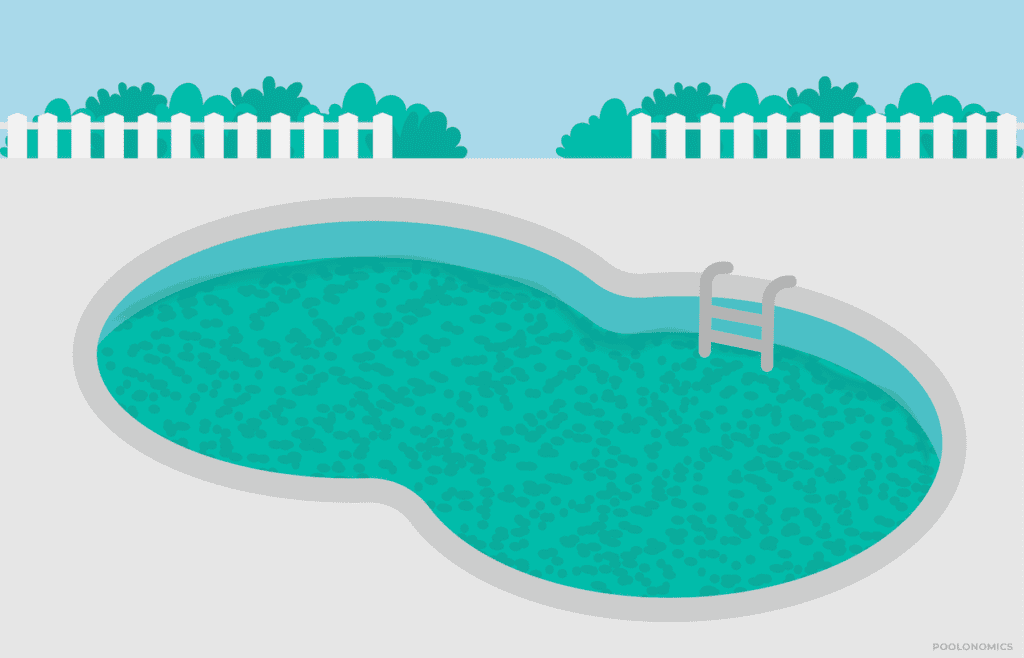
Green algae is by far the most common type of algae found in swimming pools, and that rings true for saltwater pools, too.
This little devil can take hold and grow very quickly, seemingly out of nowhere, so you know you’ve got a green algae problem if your saltwater pool suddenly turns cloudy with a tinge of green (or worse, a deep green).
While this form of algae can float around your pool, it’s not uncommon to find it clinging to your pool floor, walls, and even sometimes fixtures like ladders, causing these surfaces to be very slimy and slippery.
Fortunately, it’s also one of the least resistant types of algae found in pools, so getting rid of it isn’t too difficult.
Mustard Algae Looks Like Clumps of Sand
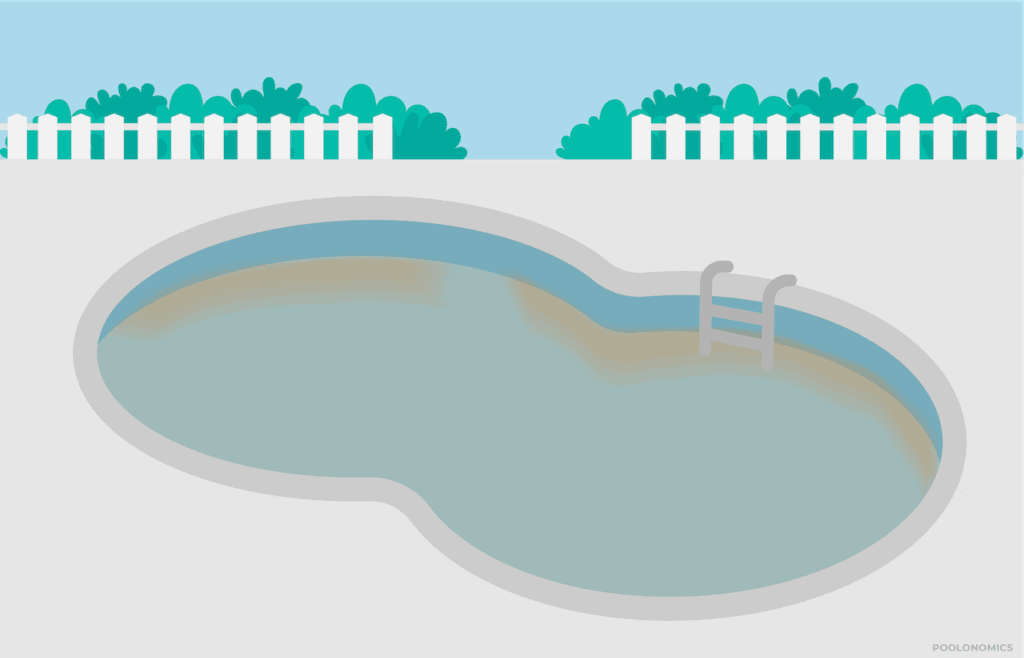
Yellow or mustard algae looks a bit like clumps of sand or pollen in the corners and creases of your pool, often with a yellow-brownish tint to it.
It’s also a very clingy type of algae. It likes to latch itself on pretty much anything it comes into contact with, including your pool equipment, floats, toys, and yes… even your swimming costume.
For that reason, if you have this type of algae, the contamination likely extends beyond just your pool surfaces.
The worst part? This one is far more chlorine resistant than green algae and requires a more aggressive approach in order to get rid of it.
Black Algae Starts as Black Spots on Your Walls
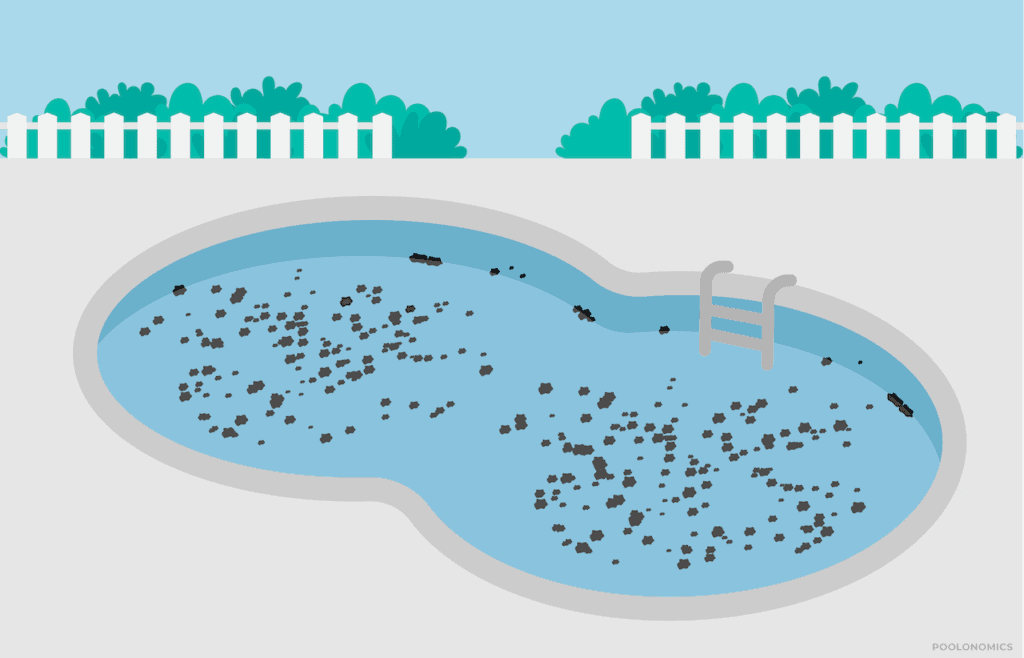
Black algae aren’t actually at all, it’s bacteria. It’s often referred to as algae because it shares some of the same characteristics.
This “algae” appears as small black spots or freckles along your surfaces, such as the pool floor, walls, and steps.
It also likes to root itself deep within porous surfaces which makes it more prevalent in concrete and gunite pools, especially those with an aggregate finish – though it’s not unheard of in vinyl and fiberglass pools.
This burrowing-like approach along with an unusually tough protective layer is what makes black algae so difficult to remove, and why it’s considered by most pool owners to be the worst type of algae to deal with – even though it isn’t technically algae.
Getting rid of black algae requires the most aggressive approach and potentially even several rounds of treatment if not an acid wash.
Pink Slime Coats Your Walls and Fixtures
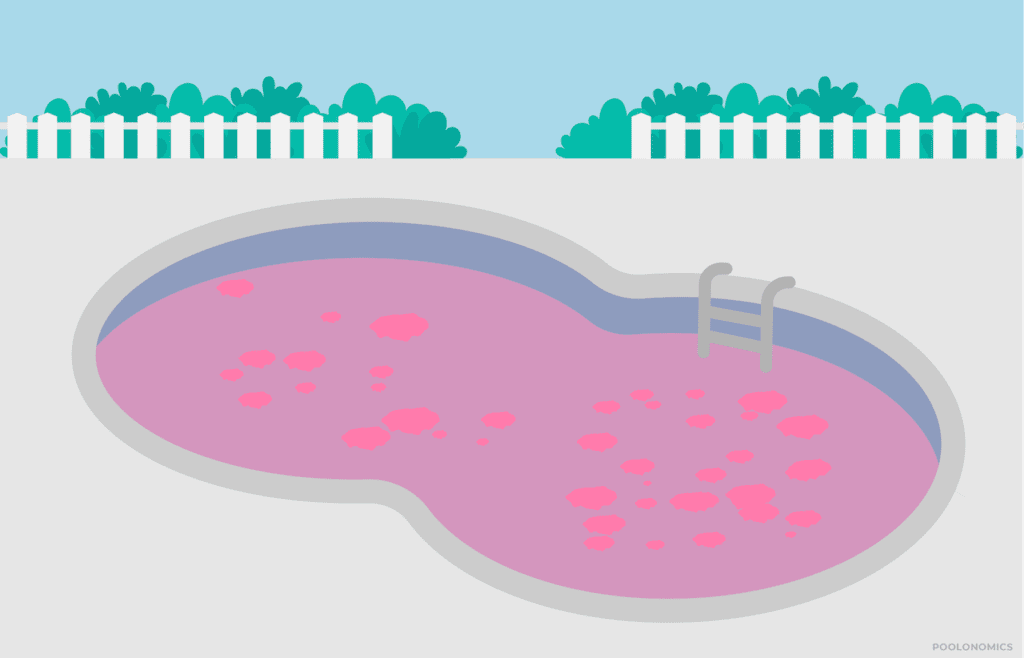
Pink slime is also not algae, it’s a bacterial growth that’s often confused as algae.
As the name implies, it’s a reddish-pink, slimy substance that coats pool surfaces and fixtures, such as drains and light fixtures. It particularly thrives in stagnant water or areas of your pool with limited flow.
While algae itself isn’t harmful, the bacteria it breeds is; which is the exact reason this substance is potentially hazardous to your health. It’s known to cause respiratory tract issues, pneumonia, and even urinary tract infections.
If that wasn’t bad enough, this nasty-looking bacteria often grow alongside a fungus known as “white water mold” (which looks a bit like pieces of shredded tissue paper in the water), so you may also have to deal with that.
Getting rid of pink slime can be a little more stubborn than green or mustard algae depending on the severity, but not quite as stubborn as black algae.
Why You Shouldn’t Use Algaecide to Kill Algae
That’s right, algaecide is NOT the answer.
Algaecides are a preventative measure, not something you should use to treat an existing algae problem.
Here’s what the pool stores don’t want you to know:
Chlorine is more effective than algaecide when it comes to dealing with algae, especially in higher doses such as those seen after using chlorine-based shock treatment.
Even though saltwater pools are still chlorine pools, it only takes a momentary drop in chlorine levels for algae to take hold, and that’s when a higher dose of chlorine (known as shock treatment) is needed to reign it back in.
How to Get Rid of Algae in a Salt Water Pool (The Best Way)
Getting rid of algae in a salt pool is very similar to how you would approach algae in a traditional chlorine pool, so there’s nothing particularly unique or special about what we’re teaching here.
With that being said, this is still a delicate process and the fundamentals make all the difference, so it’s important to follow these steps to the letter.
Important: Turn off your pump before starting this process.
Step 1. Scrub Everything
Grab a pool brush and start scrubbing all the surfaces of your pool, including the floor, walls, steps, ladders, and anything else that makes contact with your pool water.
If you have a concrete or gunite saltwater pool, we recommend investing in a heavy-duty brush as this will be more effective against stubborn algae.
No products found.
The idea here is to dislodge any algae clinging to those surfaces, which effectively does three things:
- Allows you to vacuum a large amount of it up before introducing chemicals, making it significantly easier to deal with.
- Allows you to expose more of it to your water, which means your chlorine can attack it from all angles.
- Allows your filtration system to take care of whatever dead algae remain at the end of this process.
And don’t worry if you can’t get that last bit of deep-rooted algae off your walls, as merely exposing it to the sanitizer in the water should be enough to finish it off.
If you have mustard or black algae, scrub even more thoroughly. Consider brushing everything multiple times with a little more pressure than is probably comfortable. Pay particular attention to the corners, fixtures, and grooves of your pool steps.
Step 2. Vacuum Up the Loose Algae
The last thing you want to do is to clog and contaminate your filter up with all that floating algae, assuming it isn’t already clogged (more on that later).
The good news is, you can vacuum your saltwater pool to remove the vast majority of algae without overwhelming the filtration system.
Unfortunately, if you have an automatic pool cleaner, you won’t be able to use it for algae (or slime) removal; it’s simply not designed for that job. Instead, you’ll need to suck it up by hand using a manual pool vacuum.
No products found.
Just be sure to set the vacuum to waste so the algae-infested water isn’t being sent back into the pool, as that would defeat the purpose of doing all this manually.
Finally, you’ll probably need to refill the pool after vacuuming to make sure it’s back to normal levels (midway up your skimmer opening), as this process can remove a fair amount of water.
Step 3. Test and Balance Your Water
Before we get to treating the water, it’s REALLY important you balance your chemistry so the shock treatment can work at full capacity.
After all, shock is just chlorine on steroids, and chlorine always works best when the rest of your pool chemistry is in check. Not doing this will take the kick out of your shock treatment and put you back at square one.
Before doing any balancing, you’ll obviously need to test the water to identify any chemical deficiencies. If your kit doesn’t test for salinity, it’s also worth
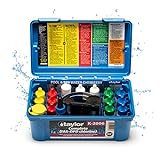
This is also where you turn your pump and filtration system back on as it will circulate any chemicals that need to be added.
We probably don’t need to tell you how to balance your water, but let’s summarize it briefly just in case.
Here’s a quick reference for balancing a saltwater pool:
- pH level between 7.2 and 7.6 (this is particularly important)
- Total alkalinity between 80 and 120 ppm
- Stabilizer (cyanuric acid) between 70 and 80 ppm
- Calcium hardness between 200 and 400 ppm
- Salinity level between 2700 and 4500 ppm (check your salt cell manual as this ranges by model)
Once your pool is scrubbed, vacuumed, and all your levels are within the optimal range, you’re ready for the fun part.
Step 4. Shock Your Pool
Now you’re going to use a heavy load of chlorine to kill the algae, otherwise known as shocking.
No products found.
You’re probably already familiar with this process as it should be part of your weekly or twice-monthly maintenance schedule. Doing so cleanses the water of chloramines and heavy contamination, and also prevents algae.
In fact, regular shocking is one of the best preventative measures against algae in a saltwater pool, but we’ll talk more about prevention later.
Now, here’s the important part:
To shock your pool, you would normally add a 1lb bag of shock for every 10,000 gallons of water in your pool. (If you don’t know how many gallons your pool holds, use this pool volume calculator.)
While this may be enough for early-stage algae, you’re going to need a double dose for more severe cases. Basically, if your water is a darker shade of green, use 2lb of shock per 10,000 gallons.
You’ll need to allow the shock to work for at least 8 hours without direct sunlight, so it’s best to apply the treatment in the evening and let it do its thing throughout the night.
Don’t forget to leave your pump running as this will also help to properly circulate the treatment overnight.
If you have a bad case of mustard, black algae, or pink slime, you’ll need an even more concentrated shock treatment to kill it, possibly as much as 3lb of shock per 10,000 gallons.
Step 5. Check Your Water
By the next morning, if the treatment worked, your pool water should have lost the colored tint caused by algae and be a lot more cloudy.
You should also see plenty of dead algae floating around, and, depending on how cloudy it is, you may even see clumps sitting at the bottom of your pool. You’ll know it’s dead if it’s gray or white in color.
In that case, your filter should be able to take care of the rest.
Depending on the size of your pool and the pump you’re using, it may take a while for a full turnover. You may have to allow up to 24 hours for all the loose, dead algae to be properly filtered out.
If the water hasn’t changed or hasn’t changed much (e.g. it’s still green), you’ll need to do another round of shock treatment while upping the dosage.
Step 6. Test Your Water (Rebalance If Necessary)
Yes, you need to do this again.
Even after your shock treatment wears off, it will have a noticeable impact on the rest of your pool chemistry and may push it slightly out of balance.
The most common type of pool shock used is calcium hypochlorite, which is a highly alkaline, calcium-based shock.
In other words, other than raising your sanitizer levels, it’s also going to raise your pH and calcium levels in particular. Of course, anything that raises your pH will also raise your total alkalinity level.
In other words, regardless of how clear your water looks at this point, it’s important to test everything again using a pool testing kit to see what needs to be adjusted.
This is not only to make the water safe for swimming, but it will reinforce your defenses against further algae blooms, especially if any traces of algae remain after shocking.
Step 7. Clean or Replace Your Filter
If all has gone to plan, your pool water should now have been turned over (or cycled) at least once through your filtration system.
As a result, the filter is going to be clogged with all that dead algae as well as the usual stuff a filter has to deal with.
While your water should be virtually back to normal in terms of clarity, the filter itself is going to be clogged with all that dead algae as well as the usual debris a pool filter has to deal with.
Not only can this potentially reintroduce algae spores back into the water, but a clogged filter also inhibits circulation and prevents it from working at full capacity, so this is a good time to clean your filter, or possibly even replace it.
If you have a sand filter or DE filter, you can either backwash it or replace the filter media depending on how badly compromised it is.
If you have the cartridge filter, simply hosing it down likely won’t be enough to get rid of every last bit of algae. Instead, soak it in a filter cleaning solution for several hours before hosing down, or just replace the entire thing.
Step 8. Sanitize Your Equipment
Now that your pool water is sparkling again, the last thing you want to do is reintroduce algae by mistake.
Algae can live outside of water for several weeks or even months, so any equipment you used throughout this process needs to be thoroughly cleaned and sanitized before being used again.
This includes cleaning equipment like brushes, skimmer nets, or vacuums, as well as any floats or toys you removed from the water prior to shocking.
Failure to do this may put you right back at step 1.
How to Prevent Algae in Salt Water Pools
Prevention is by far the easiest way to deal with algae in a saltwater pool (or any pool, for that matter).
Preventing algae in a saltwater pool really comes down to staying on top of your pool care schedule and being vigilant when it comes to maintaining pool equipment or dealing with fluctuating weather conditions.
Here are the main things to keep an eye on:
- Keep your chemistry in check. Even if algae finds its way into your pool, it will always struggle to take hold if your pH, alkalinity, stabilizer, calcium, and sanitizer levels are all on point.
- Shock your pool regularly. Regular shocking is a catch-all to make sure anything that slips past your daily sanitizer is destroyed before it can cause a problem, including algae.
- Ensure proper circulation. Your filtration system is only as effective as your circulation allows for, and since your filter works alongside your sanitizer to keep your water clean, this plays a key role.
- Brush your pool regularly. Algae like to stick to surfaces and root itself into walls and fixtures. Regular brushing allows you to dislodge it early and lets your sanitizer and filter make quick work of it.
- Vacuum your pool. Even just using an automatic/robotic cleaner reduces the load on your sanitizer and prolongs the life of your filter, all of which keeps your frontline defenses stronger.
- Shower before swimming. It’s common for algae to latch onto swimwear and sometimes your body. Showering before swimming is a simple way to counteract this hitchhiker.
- Wash your swimwear. For the same reasons mentioned above, it’s worth washing your swimwear as often as possible to remove any traces of algae or other contaminants.
- Regularly clean your equipment. Algae doesn’t stop at your surfaces or fixtures, it grabs onto practically anything that makes contact with your water, so get into the habit of cleaning everything.
Stop, Shock, and Roll.
The most powerful weapon against algae in saltwater pools is still good ol’ fashioned chlorine.
This is true for the treatment of algae in the form of concentrated shock, or for the prevention of algae in the form of low, steady levels of chorine produced by your saltwater generator.
